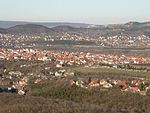Konkoly Observatory (Hungarian: Konkoly Thege Miklós Csillagászati Intézet; obs. code: 053) is an astronomical observatory located in Budapest, Hungary is part of the Research Centre for Astronomy and Earth Sciences (Hungarian: Csillagászati és Földtudományi Kutatóközpont) and belongs to the Eötvös Loránd Kutatási Hálózat. It was founded in 1871 by Hungarian astronomer Miklós Konkoly-Thege (1842–1916) as a private observatory, and was donated to the state in 1899. Konkoly Observatory, officially known as ELKH CSFK Konkoly Thege Miklós Csillagászati Intézet in Hungarian, is the largest astronomical research institute in Hungary, and hosts the largest telescopes in the country. The Observatory has more than 60 researchers, a quarter of them are non-Hungarian.
The main research areas include stellar structure and evolution, stellar and solar activity, variable stars, star and planetary formation, interstellar material, exoplanets, large sky survey, Solar System studies, nuclear astrophysics, high energy astrophysics including supernovae, gamma-ray bursts and other transient events, radio astronomy, galactic archeology, extragalaxies, designing and manufacturing astronomical instrumentation and cubesats, as well as history of astronomy. The Institute has a close collaboration with Hungarian universities, the researches teach and supervise students at ELTE and Szeged Universities. Konkoly Observatory runs the assistant researcher (Hungarian: demonstrátor program introducing undergraduate students to scientific research and using astronomical telescopes and instruments. The Observatory hosted 5 Lendület-grants, 2 ERC-projects and several national large infrastructure projects (GINOP).
As well as performing astronomical research, the observatory published the Information Bulletin on Variable Stars on behalf of the International Astronomical Union.










